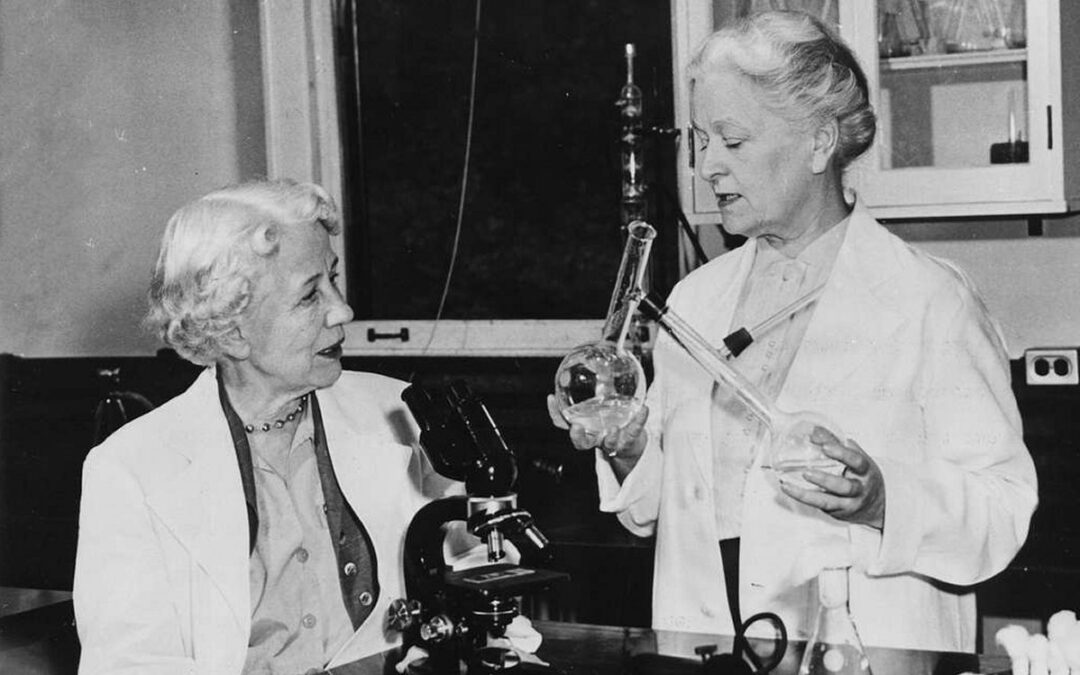Most people would rather forget the last time they had to deal with athletes food, diaper rash, jock itch, or a yeast infection. But isn’t it nice to know there is a prescription to make it go away? Imagine a world where common fungal infections had no reliable cure. That was the reality before the groundbreaking discovery of Nystatin by Rachel Fuller Brown and Elizabeth Lee Hazen (pictured above). The year was 1948, and Rachel Fuller Brown and Elizabeth Lee Hazen ended up working together through their shared work in microbiology, despite being in different locations. Wait, what, collaboration hundreds of miles apart, without the internet? How is this possible? It’s called communication, and it has allowed distributed work and spans of control to exist back to Roman times. They didn’t have the luxury of a real-time slack channel, but they still managed to survive. Even if communication meant waiting for information or materials to arrive days after it was sent.
In the case of Rachel and Elizabeth, their collaboration was made possible by the structure of the New York State Department of Health, where both were employed but in separate branches.
How They Came Together
Rachel Fuller Brown was born in 1898 in Springfield, Massachusetts. She had a deep passion for chemistry from an early age and pursued her education in the field. Rachel earning a Ph.D. in organic chemistry from the University of Chicago. Brown dedicated her career to medical research, focusing on developing antibiotics and antifungal agents.
Elizabeth Lee Hazen, born in 1885 in Mississippi, had a background in bacteriology. She studied at the University of Tennessee and later earned a master’s degree from Columbia University. During World War II, she worked on developing treatments for bacterial infections. Hazen’s expertise in microbiology complemented Brown’s chemistry background, making them an ideal research team.
Elizabeth Lee Hazen worked in New York City as a microbiologist. She was screening soil samples for microorganisms that might have medical benefits. Meanwhile, Rachel Fuller Brown, a chemist, worked in Albany at the Division of Laboratories and Research. There she analyzed and tested chemical compounds.
Their collaboration began when Hazen identified a promising antifungal compound from a soil sample. However, she needed a chemist to isolate and refine the active ingredient. That’s where Brown came in. The two scientists were connected through the state health department’s research network and began working together remotely.
Working in Different Locations
Since they were stationed in different cities, they relied on an unconventional but effective method of communication. Hazen would send promising soil samples containing microorganisms via mail to Brown. She in turn would then extract and analyze the active substances. If a compound showed potential, Brown would refine it and send it back to Hazen for further biological testing.
This back-and-forth exchange continued for months until they identified and isolated Nystatin, the world’s first antifungal antibiotic. Despite never working in the same laboratory, their teamwork led to one of the most significant medical breakthroughs of the 20th century.
Their ability to collaborate across distances, using letters and shipments, highlights their dedication, resourcefulness, and innovative approach to scientific discovery. Their breakthrough came just when it was needed most. The rise of antibiotics had led to an unexpected surge in fungal infections. Nystatin became the go-to solution doctors needed.
The Impact of Remote Work
The impact went far beyond medicine. Their discovery proved valuable in preserving priceless artwork and protecting trees from fungal diseases. In 1955, they received the Squibb Award in Chemotherapy, recognizing their contributions to medical science. They were inducted into the National Inventors Hall of Fame in 1994, solidifying their legacy as pioneers in microbiology. The American Chemical Society and other scientific organizations also honored their work. And at the end of the day they donated all their royalties through the Brown-Hazen Fund.
I decided to write about them not just because they are relatively unknown and are responsible for something rather huge, that we all take for granted. But they did it while working remotely at a time when we don’t think about working remotely, and no one was trying to get people to come into a central office “just because”. I’m sure they worked in office settings but for all practical purposes, they were remote. This was not an unusual situation. The 1940s saw several notable remote collaborations despite the challenges of limited communication technology. Scientists, engineers, and intellectuals worked across distances using letters, telegraphs, and mailed samples or blueprints.
A Few Remote Work Projects From the 1940s You Might Know
One of the most famous remote collaborations in history was the Manhattan Project from 1942 to 1945. It involved scientists working across multiple locations in the U.S. to develop the first atomic bomb. Key figures like J. Robert Oppenheimer, Enrico Fermi, and Niels Bohr communicated through secure channels while working in places like Los Alamos, Oak Ridge, and Chicago. The project required coordination between physicists, chemists, and engineers, with information shared carefully due to security concerns.
Physicists like Albert Einstein, Niels Bohr, and Richard Feynman often worked on theories across continents. During the 1940s, Einstein communicated with scientists remotely about advancements in nuclear physics. This included discussions with physicists in the U.S. and Europe on topics like quantum mechanics and relativity.
With the current race for AI supremacy, you have probably heard of the Turing test. The goal is to see if a person can tell if a computer is a computer or a human. During World War II, British mathematician Alan Turing and his team at Bletchley Park worked to break the German Enigma code. While most of the work was done on-site, Turing collaborated with researchers and intelligence officers across Britain and the U.S., exchanging encrypted messages, reports, and findings. This global effort helped shorten the war by decoding enemy communications.
The Tizard Mission (1940) was a major transatlantic collaboration between British and American scientists to develop radar technology. British researcher Sir Henry Tizard and others sent crucial radar secrets to the U.S. There scientists at MIT’s Radiation Laboratory improved and mass-produced radar systems. This long-distance teamwork played a key role in Allied victories in World War II.
Conclusion
Even in the 1940s, remote collaboration played a significant role in advancing science and technology. Scientists, engineers, and researchers overcame distance through letters, coded messages, and occasional face-to-face meetings. The success of these collaborations paved the way for future innovations in global teamwork. This eventually lead to today’s digital and real-time remote work. We aren’t doing anything new with remote work, we just have better and faster communications. The lessons of how they made remote work effective 80 years ago are worth reflecting on. We may have reached a point where remote work is ubiquitous, but how to make it work has always been with us. Sometimes we just need a little reminder.



